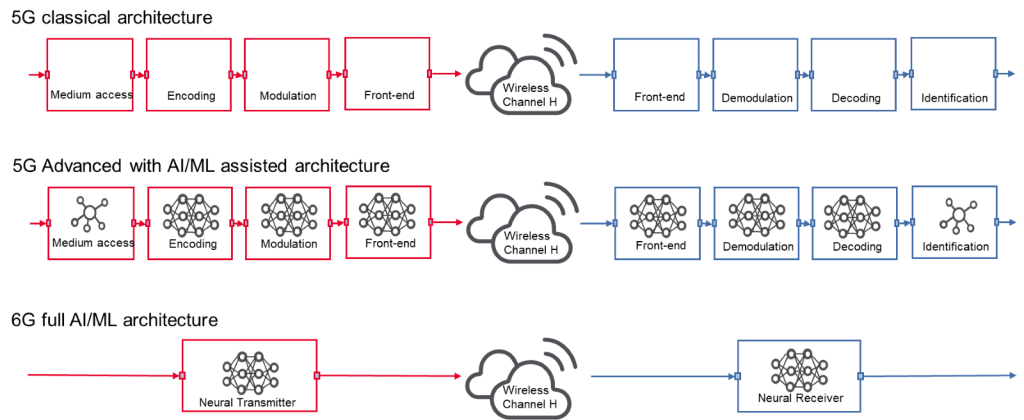As 5G matures, AI and ML are already being introduced for study by the 3rd Generation Partnership Project (3GPP), the standardization body that maintains cellular standards.
The artificial intelligence (AI) revolution is here. People are receiving first-hand experiences through the power and potential of deep neural networks and machine learning (ML) with the public release of applications like ChatGPT. ChatGPT is a language model – it has been trained on text from the vast amount of text-based content on the internet and books allowing it to generate human-like text. This type of application is a perfect example of the strengths of AI. It can optimize an output to a complex scenario based on large sets of training data.
Wireless networks are inherently complex, generate massive amounts of data, and have been growing in complexity with each new generation of technology that is introduced. This makes AI an ideal tool to optimize wireless networks.
Outside of the 3GPP and the air interface, O-RAN ALLIANCE is exploring how AI / ML can be used to improve network orchestration.
Sarah LaSelva, Director of 6G Marketing | Keysight Technologies
AI in 5G Networks
As 5G matures, AI and ML are already being introduced for study by the 3rd Generation Partnership Project (3GPP), the standardization body that maintains cellular standards. Applications of AI under consideration are primarily in the air interface, including network energy saving, load balancing, and mobility optimization. Potential use cases in the air interface are so numerous that a small subset has been selected for study in the upcoming 3GPP Release 18, including channel state information (CSI) feedback, beam management, and positioning. It is important to note that 3GPP is not developing AI / ML models. Rather it seeks to create common frameworks and evaluation methods for AI / ML models being added into different air interface functions[1].
Outside of the 3GPP and the air interface, O-RAN ALLIANCE is exploring how AI / ML can be used to improve network orchestration. For example, O-RAN ALLIANCE has a unique feature in its architecture called the RAN Intelligent Controller (RIC) that is designed to host AI / ML optimization applications. The RIC can host xApps, which run in near real-time, and rApps, which run in non-real-time. xApps for improving spectral efficiency and energy efficiency and rApps for network orchestration that leverage AI already exist today. More xApps/rApps and applications using AI / ML in the RIC will become available as the O-RAN ecosystem grows and matures.

AI-Native 6G Networks
6G is in its infancy, but it is already clear that AI / ML will be a fundamental part of all aspects of future wireless systems. On the network side, the term “AI native” is used widely in the industry despite not being officially defined. One way of looking at these AI-native networks is to extrapolate the diagram above (Figure 1) based on current trends of virtualization and disaggregation of the RAN (Radio Access Network). Each block of the network is likely to contain AI / ML models that will vary from vendor to vendor and application to application (Figure 2).

AI-native networks can also mean networks that were built to natively run AI / ML models. Consider the design flow below (Figure 3). In traditional 5G networks, the air interface is made up of different processing blocks, each designed by humans. In 5G Advanced, each block will leverage ML to optimize a specific function. In 6G, it’s possible that AI will design the entire air interface using deep neural networks.

AI / ML Optimization
Building on the idea that AI / ML can be used to improve network management orchestration, 6G looks to leverage AI and ML to solve optimization challenges. For example, AI could be used to optimize the power consumption of the network by turning on and off components based on real-time operating conditions. Today, xApps and rApps accomplish this at a base station level by turning on and off power-hungry components like power amplifiers when they are not in use. However, the ability of AI to quickly solve challenging compute problems and analyze large amounts of data opens the possibility of optimizing our networks at a larger, city-wide, or national scale. Entire base stations could be turned off during low use and cells could be reconfigured to service real-time demand in an energy optimized way using the least possible resources. It is not possible to reconfigure base stations and city-wide networks in this way today—it takes days or weeks to reconfigure and test any changes made to network configurations. Though, advances in different AI techniques remain promising and are top of mind for infrastructure providers.
Conclusion
Wireless networks will not wait for 6G to start leveraging the power of AI. Active research is happening across the entire ecosystem to develop new models and integrate them into the wireless systems of both today and tomorrow. However, these models are still new and need to be evaluated for rigor and reliability. Properly training AI models on diverse data sets, quantifying their improvement over traditional techniques, and defining new test methodology for AI enabled modules are critical steps that must be taken as this new tech is adopted. As AI models and testing best practices mature, there is no doubt that AI will revolutionize wireless communications in the next 5-10 years.
Sources
[1] https://arxiv.org/ftp/arxiv/papers/2201/2201.01358.pdf
[2] [Hoy21] J. Hoydis et al, “Toward a 6G AINative Air Interface”, IEEE Comm. Magazine, May 2021.
About the Author
Sarah LaSelva, Director of 6G Marketing
Sarah leads the marketing efforts for Keysight in 6G. She has over a decade of experience in test and measurement concentrating on wireless communications, both studying and promoting the latest wireless technologies. Throughout her career she has spent time in marketing, test engineering, and applications engineering.
Prior to joining Keysight, Sarah worked at NI (National Instruments) as a product marketing manager for the software defined radio team where she gained a deep knowledge of SDR hardware, software, and wireless communications.
Sarah’s background is in microwave and millimeter wave technology. She has a BS in electrical engineering from Texas Tech University.



